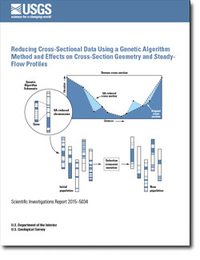Reducing cross-sectional data using a genetic algorithm method and effects on cross-section geometry and steady-flow profiles
Links
- More information: USGS Index Page
- Document: Report (639 KB pdf)
- Download citation as: RIS | Dublin Core
Abstract
Reduction of cross-sectional data using a genetic algorithm method, and the effects of data reduction on channel geometry and steady-flow profiles, were analyzed. Two reduction methods─standard and genetic algorithms─were used to reduce cross-sectional data from the Kootenai River in northern Idaho. Cross sections that are representative of meander, straight, braided, and canyon reaches were used to evalutate the reduction methods. Visual and hydraulic analyses were used to assess the methods. The genetic algorithm-reduced cross sections approximated the shape of the original cross sections better than the standard-reduced cross sections. A greater number of cross-sectional data points were needed for reduced cross sections in the straight reach, and even more in the braided reach, because a greater amount of data points are needed to adequately define cross sections that have greater topographic varability. For the genetic algorithm-reduction method, about 40 data points were needed to adequately define the shape of a reduced cross section in the braided reach compared to 10 to 20 data points in the meander and canyon reaches. The standard-reduction method needed about 70 data points for the braided reach and more than 30 points for the meander and canyon reaches. The genetic algorithm can effectively reduce data while staying within the threshold set by the maximum number of points to be included in the reduced dataset.
The effects of reduced cross-sectional data points on steady-flow profiles were also determined. Thirty-five cross sections of the original steady-flow model of the Kootenai River were used. These two methods were tested for all cross sections with each cross section resolution reduced to 10, 20 and 30 data points, that is, six tests were completed for each of the thirty-five cross sections. Generally, differences from the original water-surface elevation were smaller as the number of data points in reduced cross sections increased, but this was not always the case, especially in the braided reach. Differences were smaller for reduced cross sections developed by the genetic algorithm method than the standard algorithm method.
| Publication type | Report |
|---|---|
| Publication Subtype | USGS Numbered Series |
| Title | Reducing cross-sectional data using a genetic algorithm method and effects on cross-section geometry and steady-flow profiles |
| Series title | Scientific Investigations Report |
| Series number | 2015-5034 |
| DOI | 10.3133/sir20155034 |
| Year Published | 2015 |
| Language | English |
| Publisher | U.S. Geological Survey |
| Publisher location | Reston, VA |
| Contributing office(s) | California Water Science Center |
| Description | iv, 16 p. |
| Online Only (Y/N) | Y |
| Additional Online Files (Y/N) | N |


